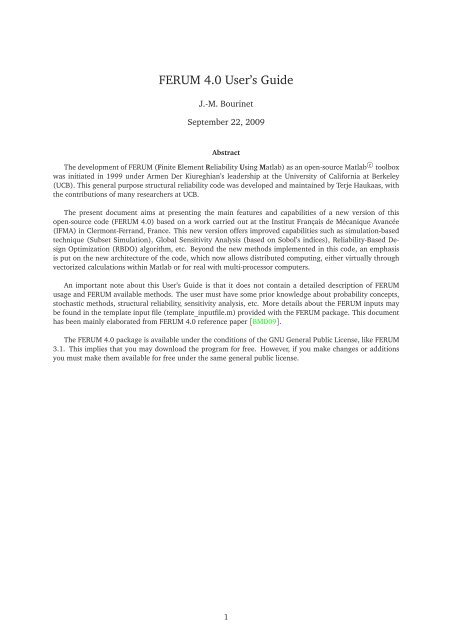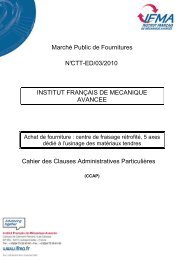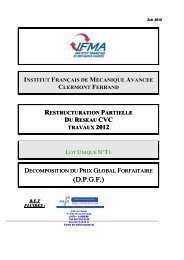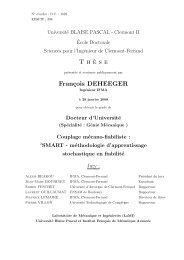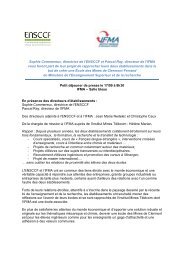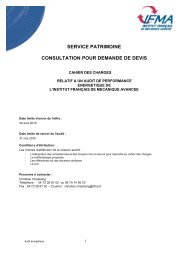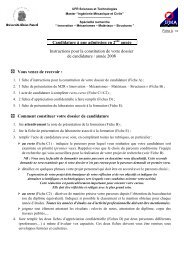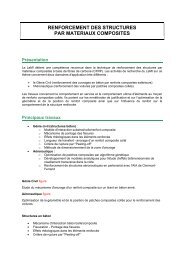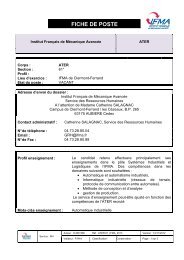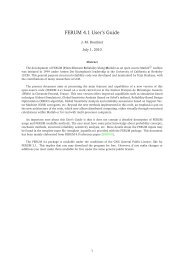FERUM 4.0 User's Guide - IFMA
FERUM 4.0 User's Guide - IFMA
FERUM 4.0 User's Guide - IFMA
- No tags were found...
You also want an ePaper? Increase the reach of your titles
YUMPU automatically turns print PDFs into web optimized ePapers that Google loves.
2.4 Vectorized/distributed computingA major change brought to <strong>FERUM</strong> <strong>4.0</strong> is that calls to the limit-state function g can be evaluated in a distributivemanner, as opposed to the sequential manner of the previous version. Every algorithm implemented in<strong>FERUM</strong> was revisited, so as to send multiple calls to g, whenever possible. If one thinks of FE-based MonteCarlo Simulation (MCS) on a multiprocessor computer, the strategy consists in sending calls to the FE codein batches, the number of jobs in each batch being equal to the number of available CPUs. This strategy isknown as distributed computing, see e.g. examples of applications in[NBGL06, DNBF09]. The number of jobssent simultaneously is tuned through the variable analysisopt.block_size. Such an option is availablein <strong>FERUM</strong>, assuming that the user has a suitable computer platform and all the necessary tools to create, sendand post-process multiple jobs (scripting language such as Perl, queuing systems such as OpenPBS on Linux,job schedulers, . . . ). The function in charge of the job allocation is obviously application-specific and is calledby gfun.m.analysisopt.multi_proc = 1;% 1: block_size g-calls sent simultaneously% - gfunbasic.m is used and a vectorized version of% gfundata.expression is available.% The number of g-calls sent simultaneously (block_size) depends% on the memory available on the computer running <strong>FERUM</strong>.% - gfunxxx.m user-specific g-function is used and able to handle% block_size computations sent simultaneously, on a cluster% of PCs or any other multiprocessor computer platform.% 0: g-calls sent sequentiallyanalysisopt.block_size = 50; % Number of g-calls to be sent simultaneouslyBased on the same developments of <strong>FERUM</strong> algorithms, it is also possible to send multiple calls to a userdefinedMatlab limit-state function written in a vectorized manner. Vectorized calculations, in the Matlabsense, eliminate the need to cycle through nested loops and thus run much faster because of the way Matlabhandles vectors internally. The principle is similar to distributed computing, the difference being that themultiprocessor computer is virtually replaced by a single computer which can handle a number of runs simultaneously(this maximum number being directly dependent on the memory available on the computer). Hereagain, the maximum number of runs sent simultaneously is controlled throughanalysisopt.block_sizevariable.For illustration purpose, on an Intel T7800 2.6GHz dual core CPU with 4Gb RAM, a crude MCS takes31 min with 1.5·10 9 samples for a basic g=r− s problem, where R and S are normal random variables, in avectorized manner (<strong>FERUM</strong> <strong>4.0</strong>), as opposed to 6 days 15 hours in a sequential manner.3 Overview of available methods3.1 FORM and reliability sensitivities/importance measures3.1.1 Basic FORMFirst-Order Reliability Method (FORM) (option 10 of <strong>FERUM</strong> <strong>4.0</strong>) aims at using a first-order approximationof the limit-state function in the standard space at the so-called Most Probable Point (MPP) of failure P* (ordesign point), which is the limit-state surface closest point to the origin. Finding the coordinates u* of theMPP consists in solving the following constrained optimization problem:u*=arg min ‖u‖ g(x(u) ,θ g )= G u,θ g = 0Once the MPP P* is obtained, the Hasofer and Lind reliability indexβ is computed asβ=α T u* whereα=−∇ u G(u*)/ ∇u G(u*) is the negative normalized gradient vector at the MPP P*. It represents thedistance from the origin to the MPP in the standard space. The first-order approximation of the failureprobability is then given by p f 1 =Φ(−β), whereΦ(•) is the standard normal cdf. As in <strong>FERUM</strong> 3.1, thenew version is based on the iHLRF algorithm, see[ZDK94] for further details. In order to take advantage ofdistributed computing, g-calls required for gradient evaluations by finite differences at a specific point of thestandard space are sent in a single batch. The same technique is applied to step size evaluation with Armijorule, where all corresponding g-calls are sent simultaneously.(5)6
% Flag for computation of sensitivities w.r.t. means, standard deviations, parameters and% correlation coefficients% 1: all sensitivities assessed, 0: no sensitivities assessmentprobdata.flag_sens = 1;% Flag for computation of sensitivities w.r.t. thetag parameters of the limit-state function% 1: all sensitivities assessed, 0: no sensitivities assessmentgfundata(1).flag_sens = 1;analysisopt.ffdpara_thetag = 1000; % Parameter for computation of FFD estimates of dbeta_dthetag% perturbation = thetag/analysisopt.ffdpara_thetag if thetag ~= 0% or 1/analysisopt.ffdpara_thetag if thetag == 0% Recommended values: 1000 for basic limit-state functions% 100 for FE-based limit-state functions3.1.3 FORM with search for multiple design pointsSearch for multiple MPPs such as described in[DKD98] is also implemented in <strong>FERUM</strong> <strong>4.0</strong> (option 11). Figure2 illustrates the use of this method, applied to a 2D example with a parabolic limit-state function[DKD98]:g(x)= g(x 1 , x 2 )= b− x 2 −κ(x 1 − e) 2 (8)where b=5,κ=0.5 and e=0.1. Both variables x 1 and x 2 are independent and identically distributed (i.i.d.)standard normal random variables.This problem is characterized by two MPPs at similar distances from the origin and basic FORM algorithmresults are therefore not valid: 1.83·10 −3 instead of 3.02·10 −3 reference value for p f . Results in Figure2 are obtained with parameter values recommended in[DKD98], i.e.γ=1.1,δ=0.75 andε=0.5. Theseparameters are set in the form_multiple_dspts.m function. All valid MPP results obtained with <strong>FERUM</strong> <strong>4.0</strong> arestored in anALLformresults array which is added as an extra field to theanalysisopt structure variable.5U-space5U-space5U-spacex20x20x20-5-5 0 5x1-5-5 0 5x1Figure 2: FORM with search for multiple design points.-5-5 0 5x13.2 SORM curvature-fitting and point-fittingAs in the previous version, <strong>FERUM</strong> <strong>4.0</strong> offers two ways for computing a second-order approximation of thefailure probability. In both methods, the SORM approximation of the failure probability p f 2 is computed withBreitung or Tvedt formulae, as in <strong>FERUM</strong> 3.1.The first method consists in determining the principal curvatures and directions, by solving an eigenprobleminvolving the Hessian of the limit-state function (option 12 of <strong>FERUM</strong> <strong>4.0</strong>). The Hessian is computedby finite differences, the perturbations being set in the standard normal space. All calls to the limit-state functioncorresponding to perturbated points are potentially sent simultaneously, as being all independent fromeach other.The second method consists in approximating the limit-state function by a piece-wise paraboloid surface[DKLH87](option 13 of <strong>FERUM</strong> <strong>4.0</strong>). This approximate surface must be tangent to the limit-state atthe design point and coincides with the limit-state at two points on each axis selected on both sides of theorigin, see Figure 4. It is built iteratively, with a limited number of iterations and all calls to the limit-statefunction, at each iteration, are potentially sent simultaneously as well. This second approach is advantageousfor slightly-noisy limit-state functions (e.g. when a FE code is involved), for problem with a large number ofrandom variables or when the computation of curvatures turns out to be problematic.8
u 2 ( u)G =2 0( u)ϕ2= cstG ( u)2 ≤ 0*u 2Oβα *u 1P *u 1G ( u) = 0G ( u)T1 = β − α u = 0Figure 3: Second-Order Reliability Method (SORM).−−( v′ i, v′n)u′n−kβ( u) 0G′ ′ =β+ +( v′ i, v′n)kβu′iFigure 4: Second-Order Reliability Method - Point-fitting method (SORM-pf).3.3 Distribution Analysis<strong>FERUM</strong> <strong>4.0</strong> offers a way to assess qualitatively (visual inspection of histograms) and quantitatively to someextent (only mean and variance in the current version) the distribution of the random variable which correspondsto the limit-state function g (option 20 of <strong>FERUM</strong> <strong>4.0</strong>). The limit-state function may either return ascalar value ifgfundata(lsf).ng field is set to 1 in the input file or multiple values ifgfundata(lsf).ngis set to a value strictly greater than 1 (please refer to the gfun.m function for more details).Parameters specific to a distribution analysis are listed hereafter.% Simulation analysis (MC,IS,DS,SS) and distribution analysis optionsanalysisopt.num_sim = 1e4; % Number of samplesanalysisopt.rand_generator = 1; % 0: default rand matlab function% 1: Mersenne Twister (to be preferred)% Simulation analysis (MC, IS) and distribution analysis optionsanalysisopt.sim_point= ’origin’; % ’dspt’: design point% ’origin’: origin in standard normal spaceanalysisopt.stdv_sim = 1; % Standard deviation of sampling distribution% in the simulation analysis3.4 Crude Monte Carlo Simulation, Importance SamplingEquation (1) is rewritten as follows:p f =∫D fXI(x) f X (x) dx= E fX[I(X)] (9)where D fXrepresents the integration domain of joint pdf f X (x), I(•) is an indicator function which equals 1 ifg(x)≤0 and 0 otherwise, and E fX[•] denotes the mathematical expectation w.r.t. joint pdf f X (x) (θ f andθ gparameters omitted for the sake of clarity).9
Parameters specific to a DS analysis are listed hereafter.% Simulation analysis (MC,IS,DS,SS) and distribution analysis optionsanalysisopt.num_sim = 200; % Number of directions (DS)analysisopt.rand_generator = 1; % 0: default rand matlab function% 1: Mersenne Twister (to be preferred)% Directional Simulation (DS) analysis optionsanalysisopt.dir_flag = ’det’; % ’det’: deterministic points uniformly distributed% on the unit hypersphere using eq_point_set.m% function% ’random’: random points uniformly distributed% on the unit hypersphereanalysisopt.rho = 8; % Max search radius in standard normal space for% Directional Simulation analysisanalysisopt.tolx = 1e-5; % Tolerance for searching zeros of g functionanalysisopt.keep_a = 0; % Flag for storage of a-values which gives axes% along which simulations are carried outanalysisopt.keep_r = 0; % Flag for storage of r-values for which g(r) = 03.6 Subset SimulationStarting from the premise that the failure event F={g(x,θ g )≤0} is a rare event, S.-K. Au and J.L. Beck proposedto estimate P(F) by means of more frequent intermediate conditional failure events{F i }, i= 1,..., m(called subsets) so that F 1 ⊃ F 2 ⊃ ...⊃ F m = F[AB01]. The m-sequence of intermediate conditional failureevents is selected so that F i ={g(x,θ g )≤ y i }, where y i ’s are decreasing values of the limit-state function andy m = 0. As a result, the failure probability p f = P(F) is expressed as a product of the following m conditionalprobabilities:m∏p f = P(F)= P(F m )= P(F m | F m−1 )P(F m−1 )=...= P(F 1 ) P(F i | F i−1 ) (13)i=25Unknownlimit−state5Unknownlimit−stateu 20u 20First threshold y 1−5−5 0 5u 1(a)First threshold y 1−5−5 0 5u 1(b)5Unknownlimit−state5Unknownlimit−stateu 20u 20Second threshold y 2Last threshold y =y =0 m 3−5 0 5−5−5 0 5−5u 1(c)u 1(d)Figure 8: Main steps in Subset Simulation.12
Each subset event F i (and the related threshold value y i ) is determined so that its corresponding conditionalprobability equals a sufficiently large valueα, in order to be efficiently estimated with a rather smallnumber of samples (in practiceα≈0.1-0.2, set byanalysisopt.pf_target parameter). In essence, thereis a trade-off between minimizing the number m of subsets by choosing rather small intermediate conditionalprobabilities and maximizing the same probabilities so that they can be estimated efficiently by simulations.The first threshold y 1 is obtained by a crude MCS, so that P(F 1 )≈α (see Figure 8, subplot (a)). For furtherthresholds, new sampling points corresponding to{ F i | F i−1 } conditional events are obtained from MarkovChains Monte Carlo (MCMC), based on a modified Metropolis-Hastings algorithm, see green star points in figure8, subplot (b) corresponding to i= 2 case. The process is repeated until a negative threshold y i is found.This is therefore the last step (i=m) and y m is set to zero. The corresponding probability P(F m | F m−1 ) is thenevaluated. See Figure 8, subplot (d). The last step is reached for m=i= 3 in the present case. The coefficientof variation of the failure probability estimated from SS can be evaluated by intermediate coefficients ofvariation, weighted by the correlation that exists between the samples used for the estimation of intermediateconditional probabilities, please refer to reference[AB01] for more details.For a Subset Simulation analysis, select option 23 in <strong>FERUM</strong> <strong>4.0</strong>. Parameters specific to this specificmethod are listed hereafter.% Simulation analysis (MC,IS,DS,SS) and distribution analysis optionsanalysisopt.num_sim = 10000; % Number of samples per subset step (SS)analysisopt.rand_generator = 1; % 0: default rand matlab function% 1: Mersenne Twister (to be preferred)% Subset Simulation (SS) analysis optionsanalysisopt.width = 2; % Width of the proposal uniform pdfsanalysisopt.pf_target = 0.1; % Target probability for each subset stepanalysisopt.flag_cov_pf_bounds = 1; % 1: calculate upper and lower bounds of the% coefficient of variation of pfanalysisopt.ss_restart_from_step = -inf;% 0: no calculation% i>=0 : restart from step i% -inf : all steps, no record (default)% -1 : all steps, record allanalysisopt.flag_plot = 0; % 1: plots at each step (2 r.v. examples only)% 0: no plotsanalysisopt.flag_plot_gen = 0; % 1: intermediate plots for each MCMC chain% (2 r.v. examples only)% 0: no plots3.7 Global Sensitivity AnalysisGlobal sensitivity analysis aims at quantifying the impact of the variability in each (or group of) input variateson the variability of the output of a model in apportioning the output model variance to the variance in theinput variates. Sobol’ indices[Sob07] are the most usual global sensitivity measures. They can be evaluatedin <strong>FERUM</strong> <strong>4.0</strong>.We consider here a model given by:Y= g(X)= g X 1 , X 2 ,..., X nwhere X=(X 1 , X 2 ,..., X n ) is a vector of n independent random input variates, g is a deterministic model andY is a scalar random output.In order to determine the importance of each input variate, we consider how the variance of the output Ydecreases when variate X i is fixed to a given x i * value:where V(•) denotes the variance function.(14)V Y| X i = x i * (15)Since x i * value is unknown, we take the expectation of Equation (15) and, by virtue of the law of totalvariance, we can write:V E Y| X i = V(Y)− E V Y| Xi(16)13
The global sensitivity index of the first-order is defined as follows, for i= 1,..., n:S i = V E Y| X i= V iV(Y) VIndices of higher orders are defined in a similar manner, e.g. for the second-order:(17)S i j = V E Y| X i , X j− Vi − V jV(Y)First-order indices inform about the influence of each variate taken alone whereas higher order indices accountfor possible influences between various parameters. Total sensitivity indices are also usually introduced.They express the total sensitivity of Y variance to X i input, including all interactions that involve X i :∑S Ti= S k (19)where i⊂k denotes the set of indices containing i.From a computational viewpoint, Sobol’ indices can be assessed using a Crude Monte Carlo (CMC) ora Quasi-Monte Carlo (QMC) sampling procedure (analysisopt.sampling respectively set to 1 or 2). Thislatter technique is based on low-discrepancy sequences, which usually outperform CMC simulations in terms ofaccuracy, at a given computational cost. Both CMC and QMC sampling procedure are implemented in <strong>FERUM</strong><strong>4.0</strong>. Another available option consists in building a Support Vector surrogate function, by regression on a sampleset of well-chosen sampling points (analysisopt.SVR set to ’yes’). The size of the learning database(number of these well-choosen sampling points) is specified by the field analysisopt.SVR_Nbasis. Thisoption based on statistical learning theory proves to be a rather cost efficient technique for evaluating sensitivitiesof models of moderate complexity.For a Global Sensitivity Analysis, select option 50 in <strong>FERUM</strong> <strong>4.0</strong>. Parameters specific to this analysisare listed hereafter.i⊂k= V i jV% Global Sensitivity Analysis (GSA) analysis optionsanalysisopt.sampling = 1; % sampling = 1: Sobol’ indices are assessed from% Crude Monte Carlo (CMC) simulations% 2: Sobol’ indices are assessed from% Quasi Monte Carlo (QMC) simulationsanalysisopt.Sobolsetopt = 0;% Sobolsetopt = 0: Sobol’ sequences from Matlab% Statistic toolbox% 1: Sobol’ sequences from Sobol’% ( Broda - http://www.broda.co.uk/ )analysisopt.SVR = ’no’; % SVR = ’yes’: a SVR is built as a surrogate to% the physical model. Sobol’ indices% are assessed on the SVR surrogate% ’no’: no SVR surrogate is built. Sobol’ indices% are assessed on the physical model,% by means of gfundata data structureanalysisopt.first_indices = 1;analysisopt.total_indices = 1;analysisopt.all_indices = 1;(18)% first_indices = 1: assessment of first order indices% 0: no assessment% total_indices = 1: assessment of total indices% 0: no assessment% all_indices = 1: assessment of first order, second order,% ..., all order indices% (analysisopt.first_indices must be set to 1)% 0: no assessmentanalysisopt.NbCal = 30; % Number of replications of Sobols’ indices assessments% (based on the same SVR surrogate, if analysisopt.SVR = ’yes’)% NbCal = 1: one single assessment% NbCal > 1: assessment of mean and variance% for each Sobols’indice% Global Sensitivity Analysis (GSA)- SVR optionsanalysisopt.SVRbasis = ’CVT_unif’; % SVRbasis =% ’Sobol_norm’: Points are deterministically generated% in the standard space (normal distribution)% (use of Sobol’ sequences in [0 1] hypercube)% ’CVT_unif’ : Points are deterministically generated% in an hypersphere with a specific radius% (use of Voronoi cells)analysisopt.SVR_Nbasis = 200; % Number of points in the design of experiments14
analysisopt.gridsel_option = 1; % SVR parameter for cross validation search (do not modify)% Parameters C, epsilon and sigma (RBF kernel is chosen) are determined in the train_SVR.m function.% However, the user may have some knowledge of the problem in order to define a grid search% for the hyperparameters (C, epsilon, sigma)analysisopt.n_reg_radius = 200000; % Number of samples for assessing the radius of the% learning hypersphere, when analysisopt.SVRbasis = ’CVT_unif’analysisopt.svm_buf_size = 3500^2; % RAM-size dependent parameter for eval_svm.m function3.8 Reliability-Based Design Optimization<strong>FERUM</strong> <strong>4.0</strong> now offers Reliability-Based Design Optimization (RBDO) capabilities. The problem of interestreads, in its most basic and general formulation:min c(θ) s.t.f 1 (θ) ,..., f q−1 (θ)≤0θ(20)f q (x,θ)=β t −β(x,θ)≤0where:• θ stands for the design variables of the problem, either purely deterministic variablesθ g or distributionparametersθ f ,• c(θ) is the cost function to be minimized,• f 1 (θ),..., f q−1 (θ) is a vector of(q− 1) deterministic constraints over the design variablesθ,• f q (x,θ) is the reliability constraint enforcing the respect of the design rule referred to as the limit-statefunction and considering the uncertainty to which some of the model parameters x are subjected to.β tis the targeted safety index.One way to answer the problem in Equation (20) consists in a brute-force outer optimization loop over thereliability evaluation, here termed “Nested bi-level approach” (N2LA). This might be computational expensivein the case of simulation-based methods such as MCS and DS, as addressed in[RP04] and[RP07] respectively.However, if based on FORM, this brute-force method gives a solution within a reasonable amount ofcalls to the limit-state function. The outer optimization loop makes use of the Polak-He optimization algorithm[Pol97]and requires the gradients of both cost and constraints functions, which themselves require thegradient of the reliability indexβ w.r.t. design variablesθ.Previous RBDO applications of the Polak-He algorithm showed that its rate of convergence was highlydependent on the order of magnitude of the design parameters, cost and constraints functions. In <strong>FERUM</strong> <strong>4.0</strong>,all these values are normalized at each Polak-He iteration, thus improving and ensuring convergence, whateverthe initial scaling of the problem in Equation (20). Convergence to an optimum is assumed to be obtainedwhen the cost function has reached a stable value and all the constraints are satisfied, i.e. f 1 (θ),..., f q (θ)≤0.In order to carry out a N2LA FORM-based RBDO analysis, select option 40 in <strong>FERUM</strong> <strong>4.0</strong>. The currentimplementation is so far restricted to deterministic parameters as design parameters, i.e. θ=θ g . The costfunction (rbdo_fundata.cost field) is expressed in the form c(θ)=c 0 + c f p f , where p f represents thefailure probability. Deterministic constraints are defined by means of therbdo_fundata.constraint field.Parameters specific to the RBDO analysis are listed hereafter.% Cost function in the form:% c_0 + c_f * p_frbdo_fundata.cost = { ’4/3.*pi.*(r1.^3 - r0.^3)’ % c_0 term’0e2 * 4/3.*pi.*(r1.^3 - r0.^3)’ }; % c_f termrbdo_fundata.constraint = { ’- r0 + 40’% Deterministic constraints:’r1 - 150’ % fi
3.9 Random fields(nothing available yet)4 Getting startedYou might want to check out how <strong>FERUM</strong> works by running one of the examples provided with the programpackage. To do so, proceed as follows:1. Go to the <strong>FERUM</strong> <strong>4.0</strong> homepage http://www.ifma.fr/<strong>FERUM</strong>/.2. Download the <strong>FERUM</strong><strong>4.0</strong>.zip archive file and extract all compressed files to a directory of your choiceon your harddisk where you wish to save all <strong>FERUM</strong> files (extraction with pathnames).3. Before you can start using the toolbox, you must to add all <strong>FERUM</strong> subdirectories (aster_files, dir_simulations,etc.) to your Search Path, so that Matlab knows where to look for them. This is done by usingone of the three following options:• select “Set Path” in the “File” menu in Matlab,• select subdirectories in the Current Directory Browser, then right click, “Add to path”, “Selectedfolder and Subfolders”,• use the addpath.m function.4. Read one of the example inputfiles into your Matlab workspace. This can be done by issuing the command>> inputfile_xxx in Matlab. You now have the necessary input parameters for a reliabilityanalysis in your current Matlab workspace.5. Issue the command>> ferum in the Matlab workspace.6. Choose a specific option (e.g. option10 for a FORM analysis).7. The program now performs an analysis corresponding to the selected option and gives you intermediateresults/information as it runs.8. If the analysis is successful, you will finally see an overview of the available result parameters on thescreen. These results are gathered in the fields of a specific structure in the Matlab workspace (e.g.formresults if a FORM analysis is run).5 Organization of <strong>FERUM</strong> <strong>4.0</strong> m-filesMain directory:• ferum.m main file• definition of distributions• <strong>FERUM</strong> pre-processing files (update_data.m, distribution_parameter.m)• Nataf model specific files including mod_corr_solve.m main file (files necessary for FORM sensitivitiesin the sensitivities directory)• Mapping from physical space to standard space (and reverse)• Limit-state function main file (gfun.m) and gfunbasic.minputfile directory:• Examples of inputfiles• Input file template (inputfile_template.m)gfunction directory• Examples of limit-state functions defined through Matlab .m filesFORM directory• Search for a single design point with the iHL-RF algorithm (form.m)• Search for possible multiple design points (form_multiple_dspts.m, via calls to form.m)• Auxiliary files16
sensitivities directory• All files necessary to assess FORM sensitivities w.r.t. distribution parametersθ f (means, standard deviations,correlation, distribution parameters) and deterministic parametersθ g in the limit-state functionSORM directory• SORM curvature-fitting method (sorm_cfh.m)• SORM point-fitting method (sorm_pf.m)• Auxiliary filesdistributions directory• Distribution of the limit-state function based on a Monte Carlo simulation (distribution_analysis.m)simulations directory• Crude Monte Carlo (CMC) simulation or Importance Sampling (IS) (simulation_single_dspt.m, simulation_single_dspt_lowRAM.m)• Mersenne Twister pseudo-random number generator (source file twister.cpp, Windows .dll file, Linux32-bit .mexglx file)dir_simulations directory• Directional Simulation (dir_simulation.m) with either random or deterministic directions (through callsto eq_point_set.m function and auxiliary files in eq_sphere_partitions directory)subset_simulations directory• Subset Simulation (subset_simulation.m)• Auxiliary filesSobol directory• Global Sensitivity Analysis based on Sobol’ indices (Sobol_SA.m), either through calls to the originallimit-state function or to a SVR surrogate (Support Vector Regression).• Sobol’ quasirandom sequences generated by means of the Matlab Statistical Toolbox or the sobolseq51Windows .dll file from BRODA (BRODA subdirectory)• SVR training and evaluation based on the spider Toolbox (spider subdirectory)• Training samples possibly re-arranged by means of Centroidal Voronoi Tessellation (CVT subdirectory)N2LA directory• Nested bi-level RBDO analysis based on FORM and gradient ofβ index w.r.t. design variables (N2LA.m)• Polak-He optimization algorithm (ph_quadprog.m)• fun.m auxiliary fileferum_in_loop directory• Example script files showing how to call <strong>FERUM</strong> in a silent modeaster_files directory• Files required for external calls to Code_aster Finite Element code in a sequential way (inputfile, gfunaster.mfunction called by gfun.m, Windows specific files, Code_aster template files, gawk binary, gawkfile for post processing of FE results)17
References[AB01] S.-K. Au and J.L. Beck. Estimation of small failure probabilities in high dimensions by subsetsimulation. Probabilistic Engineering Mechanics, 16:263–277, 2001.[Bje88] P. Bjerager. Probability integration by directional simulation. Journal of Engineering Mechanics,114(8):1285–1302, 1988.[BL08] J.-M. Bourinet and M. Lemaire. FORM sensitivities to correlation: Application to fatigue crackpropagation based on Virkler data. In Proc. of the 4th International ASRANet Colloquium, Athens,Greece, 2008.[BMD09] J.-M. Bourinet, C. Mattrand, and V. Dubourg. A review of recent features and improvements addedto <strong>FERUM</strong> software. In Proc. of the 10th International Conference on Structural Safety and Reliability(ICOSSAR’09), Osaka, Japan, 2009.[DKD98] A. Der Kiureghian and T. Dakessian. Multiple design points in first and second-order reliability.Structural Safety, 20(1):37–49, 1998.[DKHF06] A. Der Kiureghian, T. Haukaas, and K. Fujimura. Structural reliability software at the Universityof California, Berkeley. Structural Safety, 28(1-2):44–67, 2006.[DKLH87] A. Der Kiureghian, H.-Z. Lin, and S.-J. Hwang. Second-order reliability approximations. Journalof Engineering Mechanics, 113(8):1208–1225, 1987.[DM07] O. Ditlevsen and H.O. Madsen. Structural reliability methods. Internet Edition 2.3.7, 2007.[DNBF09] V. Dubourg, C. Noirfalise, J.-M. Bourinet, and M. Fogli. FE-based reliability analysis of the bucklingof shells with random shape, material and thickness imperfections. In Proc. of the 10th InternationalConference on Structural Safety and Reliability (ICOSSAR’09), Osaka, Japan, 2009.[LDK86] P.-L. Liu and A. Der Kiureghian. Multivariate distribution models with prescribed marginals andcovariance. Probabilistic Engineering Mechanics, 1(2):105–112, 1986.[Lem09] M. Lemaire. Structural reliability. John Wiley, 2009.[NBGL06] L. Nespurek, J.-M. Bourinet, A. Gravouil, and M. Lemaire. Some approaches to improve thecomputational efficiency of the reliability analysis of complex crack propagation problems. InProc. of the 3rd International ASRANet Colloquium, Glasgow, UK, 2006.[Pol97] E. Polak. Optimization: Algorithms and consistent approximations. Springer-Verlag, 1997.[PS06] M.F. Pellissetti and G.I. Schuëller. On general purpose software in structural reliability - anoverview. Structural Safety, 28:3–16, 2006.[RP04] J.O. Royset and E. Polak. Reliability-based optimal design using sample average approximations.Probabilistic Engineering Mechanics, 19(4):331–343, 2004.[RP07] J.O. Royset and E. Polak. Extensions of stochastic optimization results to problems with systemfailure probability functions. Journal of Optimization Theory and its Application, 132(2):1–18,2007.[Sob07] I.M. Sobol’. Sensitivity estimates for nonlinear mathematical models. Mathematical Modelling andComputational Experiments, 1:407–414, 2007.[ZDK94] Y. Zhang and A. Der Kiureghian. Two improved algorithms for reliability analysis. In R. Rackwitz,G. Augusti, and A. Borri, editors, 6th IFIP WG 7.5 Working Conference on Reliability and Optimisationof Structural Systems, Reliability and Optimization of Structural Systems. Chapman & Hall,1994.18


